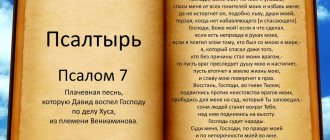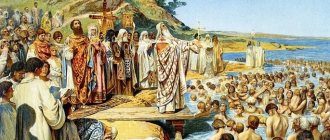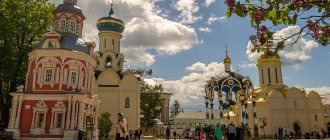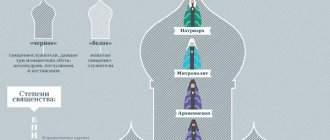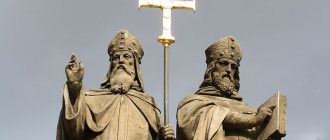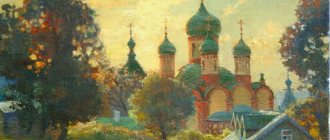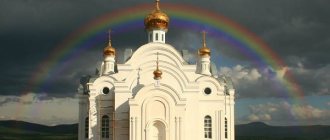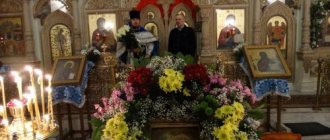This term has other meanings, see Clock (meanings).
Watch
(Greek ὧραι) - Christian public services, prayerfully consecrating a certain time of day (from 6 a.m. to 6 p.m.); consist of three psalms, several verses and prayers, selected accordingly to each quarter of the day and to the special circumstances of the Savior’s suffering. They are included in the daily liturgical circle (performed once every day).
- The first hour
(corresponding to our 7 o'clock in the morning) - sanctifies the coming day with prayer, many events are remembered: the constant praise of angels, the expulsion of Adam and Eve from paradise, the night prayer of the Lord Jesus Christ, His suffering at the trial of Caiaphas, the Last Judgment. This service arose later than the other three, which were known back in apostolic times[1]. - The third hour
(9 o'clock in the morning) - the Judgment of Pilate and, later, the descent of the Holy Spirit on the apostles, which took place at this time of day, are remembered. - Sixth hour
(12 o'clock - noon) - the fall of our ancestors and the nailing of Jesus Christ to the cross are remembered. - Ninth hour
(3 pm) - the death of the Lord Jesus Christ on the Cross is remembered.
Types of watches
Everyday
The succession (unchangeable basis) of the daily hours is contained in the Book of Hours and in the Followed Psalter, and their changeable parts: troparia and kontakia - in the Octoechos, Menaion and Triodion.
The services of the hours are performed every day and are therefore called daily or ordinary services. Each hour also has its own hour (between hours); in modern practice these interhours
are performed only on weekdays of the Nativity, Petrov and Assumption fasts. For the sake of convenience, the celebration of the hours is combined with other services, namely: the 1st hour with Matins, the 3rd and 6th with the Liturgy, the 9th with Vespers (for the Old Believers, the 9th hour is read before the Liturgy, after the 6th hour, and the hour of the 9th hour is connected with the evening hour).
Order of daily hours:
- Blessing of the priest (exclamation) - only before the Third and Ninth hours,
- The usual start is only before the Third and Ninth hours,
- Come, let's worship...
, - Three psalms ( 1st hour
: 5, 89, 100;
3rd hour:
16, 24, ;
6th hour:
53, 54, ;
9th hour:
83, 84, 85), - Glory: and now:,
- Hallelujah,
- Lord have mercy - three times,
Glory: - Troparion of the holiday or saint that happened (or troparion, Glory: second troparion),
- And now: Theotokos hour,
- Poems (one verse) of the hour,
- Trisagion according to Our Father, exclamation of the priest,
- Kontakion of a holiday or saint,
- Lord have mercy
- 40 times, - Same for all times
- this prayer is read not only at the clock, but also at the daily midnight office and at Compline (Great and Small), - Lord have mercy
(thrice), Glory: and now, - The most honest cherub,
- Bless in the name of the Lord, father.
— During the bishop’s service, in cathedrals, in stauropegial monasteries and churches, where the rector is the bishop, it is said:
“In the name of the Lord, His Holiness (Most Reverend, Most Reverend) Vladyka bless
, - The priest's cry
- Prayer of the hour (at the first hour it is read by the priest, after which the choir sings: To the chosen Voivode
. Priest:
“Glory to Thee, Christ God - Our Hope, glory to Thee
,” choir: Glory: And now:
“Bless.”
The priest makes a dismissal. The choir sings either Many years,
“I fulfilled these despots”
,
“Confirmation of those who hope in You...”
, or
“Lord have mercy”
- three times and
“Confirmation of those who hope in You...”
).
Lenten
The sequence (the unchangeable basis) of the Lenten Hours is contained in the Book of Hours and in the Followed Psalter, and their modified parts: kathismas - in the Psalter, prokemenes, paremias and sometimes troparia with kontakia - in the Lenten Triodion; when proofreading, the liturgical Gospel is used.
Lenten hours are celebrated on Monday, Tuesday, Wednesday, Thursday and Friday of the entire Holy Pentecost, on Monday, Tuesday and Wednesday of Holy Week, on Wednesday and Friday of Cheese Week (if these days of Cheese Week do not coincide with the feast of the Presentation of the Lord or a temple holiday).
The service of the hours performed during Lent has its own characteristics in comparison with the daily hours.
- At each hour, after reading the three prescribed psalms, an ordinary kathisma is read (with the exception of Mondays and Fridays at the first hour and Fridays at the ninth hour; kathismas are also not read at the first and ninth hours on Holy Monday, Tuesday and Wednesday),
- At each hour, the fasting troparion of the hour is sung three times (with two verses), with bows to the ground,
- At the first hour after the Theotokos hour, the verses of the hour are sung with repetitions: “Direct my feet according to Your Word:...”
, the last verse - three times, - At the sixth hour, the troparion of prophecy, prokeimenon, parimia,
- At the third, sixth and ninth hours the Gospel can be solemnly read,
- Instead of kontakions for saints, there are weekly troparia and theotokos,
- At the end of each hour there is the prayer of St. Ephraim the Syrian “ Lord and Master of my life...
”, with great (earthly) and waist bows, - The third, sixth and ninth hours are performed together before the fine ones.
Royal
- The sequence of the royal hours on the eve of the Nativity of Christ and the Epiphany is entirely found in the Menaion under the corresponding dates.
- The succession of the royal hours of Good Friday is entirely contained in the Lenten Triodion.
These watches received the name “royal” only in Rus'. This was due to their special solemnity, as well as the Byzantine custom of the presence of the emperor during their performance; The Byzantine tradition was continued by the Moscow tsars. Meanwhile, in the old Typicons there was no such name. Therefore, the name of the clock “great” would be more correct and consistent with the ancient Charters. See Liturgical instructions of the Moscow Patriarchate[2]. Unlike the daily and Lenten hours, they do not go back to monastic worship, but to the “song sequence” that underlies the Rule of the Great Church of St. Sophia in Constantinople, at whose services the Emperor of Byzantium was present.
They are performed with the Royal Doors open in the middle of the temple on the eve of the holidays of Christmas and Epiphany, on the so-called Christmas Eves of December 24 (January 6) and January 5 (18), and are dedicated to these sacred events, as well as on Good Friday - for the sake of the Passion of the Lord. Of the three psalms of each Royal hour, only one psalm is from the usual daily hour, and the remaining two are special for each of the three days when these hours are read. In addition to the psalms, at each hour (and they are performed in a row, from the first to the ninth), troparia, stichera and kontakia are sung for the forefeast (or passion of Christ), a prokeimenon is read, a proverb is an excerpt from the Old Testament containing a prophecy about the day being remembered, a text from the Apostle and the Gospel .
The sequence of the Royal Hours is not contained in the Book of Hours, but in the Menaion for the services of Christmas and Epiphany Eve and in the Lenten Triodion for the hours of Good Friday.
If any of the Christmas Eves falls on Saturday or Sunday, then the royal hours are moved to the previous Friday, and there is no Liturgy on that day.
Easter
The sequence of the Easter hour is entirely contained in the Tsvetnaya Triodion.
The Easter hour does not contain any psalms, but consists of hymns glorifying the Easter holiday. It is also sung instead of morning and evening prayers until Saturday morning before St. Thomas Sunday, as well as instead of Compline and the Midnight Office.
STATUTE ON THE READING OF TROPARIA AND KONDACICS AT THE CLOCK
On the days of the sixfold saints, the katavasiya is composed of the irmos of the saint’s canon from the Menaion, which are sung only 3, 6, 8 and 9 songs. Here, special irmos are assigned for catavasia, for example, on October 23, “I will open my mouth”..., or on the days of the forefeast, or after the festivities, festive irmos. Katavasia is sung after each song.
According to the 3rd song of the canon, the saint's sedal is read. If a pre-celebration or post-celebration occurs, then, according to the instructions of Chapter 48. The typikon (for example, December 26) is supposed to read the kontakion of the holiday, ikos and ipakoi.
According to the 6th song of the canon - the kontakion of the saint and ikos.
Regarding the song “It is worthy to eat...” in the Book of Hours, p. 32 it is said: “If there is no week, according to the Irmos,” we sing 9 songs of the canon “It is worthy to eat...” “If there is a week and no polyeleos, according to Katavasia the litany.” So, on Sundays and all other days on which the polyeleos is prescribed, “It is worthy to eat...” after the canon should not be sung. However, one should not conclude from this that at any other time “It is worthy to eat...” is sung. In some successions, the number of days on which one should not sing “It is worthy to eat...” includes the pre-celebration and the post-celebration, as well as all those days on which a special catavasia is prescribed after each song of the canon. During the performance of the service to the saint with great doxology, chaos is prescribed after each song.
According to the 9th song of the canon, the saint's luminary was laid (twice). “Happening, and now” - Theotokos.
If a forefeast or afterfeast occurs, then the luminaries of the holiday (three times).
All saints have stichera on praises with great doxology: “So, for example, on September 23, “stichera on praises” are placed on 4, “Glory, and now” - Menaion of the Theotokos. On the days of the forefeast or afterfeast, 4 stichera are laid, “Glory” to the saint, “And now” to the holiday.
Saints with great doxology do not have “stichera on stichera” and Matins itself ends differently than with saints who do not have a holiday sign, and saints sung on the 6th, namely: when the last hymn of praise ends: stichera on “And now” (during which the deacon opens the royal doors), then the priest proclaims: “Glory to Thee, who showed us the light,” the choir sings a great doxology: “Glory to God in the highest...” Then, as indicated in the Service Book and Book of Hours, the saint’s troparion is sung, “Glory, now "- the Sunday Theotokos according to the voice of the saint's troparion.
If a pre-feast or post-feast occurs, the troparion of the holiday is sung. “Glory” - the saint, “And now” - the holiday.
After the troparions, the deacon pronounces the litanies: “Have mercy on us, O God...” and “Let us perform the morning prayer...” Then: “Wisdom.” Choir: “Bless.” Priest: “Blessed be he...” Chorus: “Amen.” “Confirm, O God...” Priest: “Most Holy Theotokos, save us.” Choir: “Most honorable cherub...” Priest: “Glory to Thee, O Christ God...” Chorus: "Glory, even now." “Lord, have mercy” (three times). "Bless." The priest administers the dismissal. The dismissal is pronounced with the royal doors open, which are then closed and covered with a veil, the choir is pronounced for many years, after which the first hour is celebrated; In this case, the service ends with a small discharge.
POLYELEA MAINTENS
Polyeleos is closely connected with the reading of the Gospel at Matins - with all the preparatory and subsequent liturgical moments (and itself serves as an introduction, an introduction to this reading); therefore, polyeleos and the Gospel represent a unity, historically connected by internal meaning in form and content. As a result, popielia without the Gospel makes no sense and never happens.
After reading the kathisma, the royal doors open and the solemn singing of selected verses from Psalms 134 and 135 begins: “Praise the name of the Lord”... with the refrain: “Alleluia.”
While singing the verses, the priest, preceded by the deacon with candles, censes the entire church as a sign that everything is illuminated by the light of Christ and His mercy extends to everyone. First, they incense the icon of the feast and the saint located on the lectern in the middle of the temple, then they incense the entire altar. Then they go out to the soleya, first incense the right and left sides of the iconostasis, then the clergy standing at the icon in the middle of the temple, the singers in the choir and all those praying in the temple.
Polyepaeus (from two Greek words - “polis” - many and “eleos” - mercy) can be translated as follows: “much merciful, and much merciful (singing).” This comes from the fact that the polyeleos itself consists of the versification of Psalms 134 and 135 with the chorus returning at the end “For His mercy endures forever,” where the Lord is praised for many mercies to the human race and, above all, for its salvation and redemption.
The singing of the polyeleos is accompanied by the lighting of numerous lamps (why the word “polyeleos” is derived from - “many, olive, oil, oils, “much oil”, many lamps with oil). The Typikon says this: “At the beginning of polyeleos, it is appropriate to light all the candles and leave (their) handfuls until the end of the 3rd canto, and then extinguish the packs” (Typikon, ch. 24).
The Typikon regulates the time of singing the polysley as follows: on Sundays it is supposed to be sung from September 22 to December 20, and from January 14 to Cheese Week. Actually, the Typikon does not mention the polyeleos at the Sunday vigil; only the singing of the “immaculate” is noted, i.e. Psalm 118 with the adjoining troparia: “The Council of Angels...” and others. Instead of choruses, the characteristic verse of this psalm is given: “Blessed art thou, O Lord, teach me by thy justification.” There is no doubt that this is the oldest form of this section of Sunday Matins.
These “blameless” ones are sung on Sundays: 1) from the Sunday of the Myrrh-Bearers to the Sunday of Pentecost, 2) from the Sunday of All Saints until September 22, 3) from December 20 to January 14, 4) on the Sunday of the Publican and the Pharisee, 5) on 1,2,3,4 and 5 weeks of Lent.
On all other Sundays, as well as on holidays, the polyeleos is sung. If, on the indicated Sundays, when the “blameless” are prescribed, a feast day of the Lord or the Theotokos or a saint happens to be celebrated with a vigil and a polyeleos, then the “blameless” are abandoned, and the polyeleos is sung. This is indicated by the Typikon (see Chapter 17). In modern practice, parish churches have established the rule to sing exclusively polyeleos at Sunday matins all year round.
Polyeleos is especially typical for services on Sundays and major holidays (of the Lord, the Mother of God and the Great Saint), for here the mercy of God was especially felt and it is especially appropriate to praise His name in gratitude for these mercies.
During the singing of the polyeleos, the abbot is supposed to distribute candles to those serving with him (Typikon, Chapter 2).
To Psalms 134 and 135, which constitute the content of the polyeleos, in the preparatory weeks for the Great Lent (Prodigal Son, Raw Fat, Meat), it is necessary to add Psalm 136 to the polyeleos: “On the rivers of Babylon...” with “Alleluia”, i.e. to a special touching and sweet-voiced tune.
Polyeleos is followed by magnification (on the days of the Lord’s, Theotokos’, saints’ and temple holidays). The texts of magnification are contained in the Followed Psalter and Irmologion. The magnification proceeds in this order: immediately after the polyeleos, the clergy sing the magnification once in the entire cathedral. Then both choirs repeat the magnification of the same text many times. At this time, the priest and deacon perform incense. After censing, the clergy sing the magnification one more time.
After the magnification or troparia there is a small litany. It is followed by the exclamation: “For Thy name is blessed...”
Then, according to the Charter, reading is required. Before reading, there is a special session called ipakoi, during which one is not supposed to sit.
On those Sundays when a saint is celebrated, who is supposed to sing the polyeleos, the feast of the Virgin Mary, or the Presentation of the Lord, the ipakoi are supposed to read or sing the sedals of the saint or the holiday. Behind the sedal (or ipakoi) special antiphons called power antiphons are sung or read.
On Sundays, the antiphons of the present voice are sung, and on holidays, except for the resurrection, the antiphons of the 4th voice are sung: “From my youth, many passions have fought me.” On the twelve feasts of the Lord, if they happen on a Sunday, the antiphons “From my youth…” (4th tone) are also sung.
The sedate antiphon is followed by special preparation for reading the Gospel.
The deacon says: “Let’s get out there! Wisdom! Let us take in” Then follows the prokeimenon of the Gospel that will be read. The prokeimenon is either the voice of the Week, or, if a holiday occurs, the voice of the holiday.
After the prokeme, the deacon exclaims: “Let us pray to the Lord.” The chorus answers: “Lord, have mercy.” Priest: “How holy art thou, our God.” The deacon then exclaims, “Let every breath praise the Lord.” The singers repeat the same thing. And so twice. The third time the deacon pronounces the first part: “Every breath,” and the singers answer: “Let him praise the Lord.”
Deacon: “And we pray that we may be worthy to hear the Holy Gospel of the Lord God.” Chorus: “Lord, have mercy” (three times), then the deacon exclaims: “Wisdom, forgive me! Let us hear the Holy Gospel." Priest: “Peace to all,” choir: “And your spirit.” Priest: “Reading from (the name of the evangelist) the Holy Gospel.”
The singers praise the Lord, who came to proclaim the good news of His salvation of the human race: “Glory to Thee, Lord, Glory to Thee.”
Then, after the deacon’s invitation: “Let us attend,” the priest reads the Evangelium.
During the Week (i.e., on Sunday), the following in order of the 11 Sunday readings are supposed to be read (unless the twelfth, Vladychny, or temple holiday occurs). On weekdays one is supposed to read the Feast Gospel set for Matins. If a holiday coincides with a Sunday, priority is given to the Sunday Gospel.
The Sunday Gospel should be read in the altar, which in this case depicts the Holy Sepulcher (see Typikon, Chapter 2).
On other holidays, the Gospel is supposed to be read among the church, because an icon of the holiday is placed among the church, the meaning of which is proclaimed by the Gospel. After reading the Sunday Gospel, the priest takes him out of the altar and gives him a kiss. Kissing the icon and receiving the anointing of the priest with oil (that which was consecrated at Vespers with the blessing of the five loaves, wheat, wine and oil) is supposed to be done after Matins before the first Hour. However, in the long-term practice of parish churches, it has become customary to place the Gospel on the lectern next to the icon of the holiday, kiss the Gospel and icon and receive anointing or blessing from the primate, and then consecrated bread. And this happens not at the end of Matins, but during the singing of the canon. However, we must always keep in mind that here, for the sake of convenience (many people praying and the reluctance to delay them at the end of Matins), the Rule is not violated, but has received a new development.
After reading the Gospel, the choir sings: “Having seen the Resurrection of Christ...”. This chant is set to be sung at Matins on Sunday. It is also sung on the following holidays: the Exaltation of the Cross of the Lord, the Ascension of the Lord, on St. Saturday. righteous Lazarus.
On Easter Day, throughout Easter (Bright Week), as well as on all Sundays, from Easter to Ascension, this chant is sung three times.
On Pentecost, Christmas, Epiphany and Transfiguration, the song “Having seen the Resurrection of Christ...” is not sung at matins, even if these holidays fall on Sunday. It is also not sung during the week of Vai.
After “The Resurrection of Christ...”, the 50th Psalm is read. The fiftieth psalm ends with prayerful invocations of the intercession of the apostles and the Mother of God.
“Glory,” “To the Apostles, O Merciful One, Cleanse the multitude of our sins.”
“And now,” “Through the prayers of the Mother of God, O Most Merciful One, cleanse our many sins.”
Then verse 50 of Psalm is sung again: “Have mercy on me, O God, according to Your great mercy, and according to the multitude of Your compassions, cleanse my iniquity:”
The chant for "Glory and Now" just given varies depending on the holiday.
In Nedepi, preparatory to Vepic Lent, i.e. the publican and the Pharisee, the prodigal son, meat, cheese, and in Lent - until the Week of Vaiy, after reading the 50th psalm, the repentant troparion is sung for “Glory”: “Open the doors of repentance, O giver of life...” For “And now” - the second troparion : “Instruct me in the path of salvation, O Mother of God...” Then to the verse “Have mercy on me, O God...” the third repentant troparion is added: “Many of the cruel things I have done, thinking of the accursed one, I tremble at the terrible day of judgment...”
On Sunday (if it does not coincide with the Twelfth Day or a temple holiday), after the verse: “Have mercy on me, O God...”, the Sunday stichera is placed: “Jesus is risen from the grave...”
On great holidays - (the Lord's, Theotokos and temple holidays - even if they happen on Sunday), instead of the Sunday stichera, a festive stichera is sung. On feasts of great saints (with vigil or polyeleos), which do not occur on Sundays, the stichera of the feast or saint is also sung.
After this, the lithium prayer is read: “Save, O God, Thy people...”
This is followed by “Lord, have mercy” (12 times) and the exclamation: “By mercy and generosity and love for mankind...” After the exclamation, the singing of the canon begins.[30] Catavasia is placed after each song.
At the 3rd, 6th and 9th songs of the canon, everything is done in the same way as at daily Matins.
After the small litany and the exclamation of the priest: “For all the powers of heaven praise You...”, the deacon’s exclamation is supposed to be: “Holy is the Lord our God.” Chorus: repeats the same text. Then the deacon exclaims the 1st verse: “For holy is the Lord our God,” the choir again answers: “Holy is the Lord our God...”, then the deacon exclaims the 2nd verse: “Over all people is our God,” and the choir: “Holy is the Lord Our God."
Since the indicated verse is not a special glorification of the resurrection of the Lord and the omnipotence of His all-conquering power, it is supposed to be sung on St. Saturday. righteous Lazarus and on Holy Saturday.
Next are the luminaries, or exapostiparia. The order of singing luminaries and exapostilarii is regulated by the 16th chapter of the Typikon.
After the luminary-exapostilary, psalms 148, 149 and 150 are versified, in some cases antiphonally. The listed psalms are called “praise” because the word “praise” is often repeated in them and the Lord is praised; this versification is combined with the singing of stichera. These stichera are called “stichera on praise” or “stichera of praise.” They are usually sung at the end of Psalm 149 and after each verse of Psalm 150.
If a Sunday, a lord's holiday, or a feast of saints occurs with great doxology, then the text is sung in the appropriate voice: “Let every breath praise the Lord. Praise the Lord from heaven, praise Him in the highest. (Ps. 149,149) A song to God is due to you.”
On other days, psalms are sung (i.e., sung antiphonally) in the following order. Chorus: “Praise the Lord from heaven. A song to God is due to you. Praise the Lord from heaven, praise Him in the highest. A song to God is due to you.” Second chorus: “Praise Him, sun and moon” (Ps. 148:3). “Sing a new song to the Lord... (Ps. 149).
This is where the stichera “on praise” begin. “Create judgment in them, it is written...” (Ps. 149.9) “Praise God in His saints, praise Him...” (Ps. 150).
These psalms glorify the omnipotence and justice of God. If stichera on 8 are sung, then other verses are added to these verses.
The Gospel stichera is relied upon (if it happens on Sunday) on the “praise” on “Glory”. Then on “And now” the Theotokos is sung: “Most blessed art thou, O Virgin Mary...” (on Sundays, except those that coincide with the great feasts of the Lord, such as: the Nativity of Christ, the Epiphany, the Transfiguration, the Elevation of the Cross, the Entry of the Lord into Jerusalem, Pentecost). On other days there is another Mother of God.
In addition, “Blessed are you, O Virgin Mother of God...” is also sung on Lazarus Saturday (if it coincides with the Feast of the Annunciation) and on Holy Saturday (even if the Annunciation occurs).
Before the beginning of the singing of the Theotokos, the royal doors are opened, and at the end of the Theotokos, the priest proclaims: “Glory to Thee, who showed us the light.” Behind this exclamation a great doxology is sung: “Glory to God in the highest...” And in the end, Holy God, Holy Mighty, Holy Immortal, have mercy on us!” (three times).
The Trisagion is not part of the great doxology, but represents an independent part adjacent to it.
After the trisagion, if it happens on Sunday, the troparion of Sunday or the holiday is sung. If a Sunday, forefeast, afterfeast, celebration of the holiday and the twelfth feasts of the Theotokos happen, then the Sunday troparion is also sung. But on the Feast of the Lord the troparion of the feast is sung.
Sunday troparion in the weeks (1st, 3rd, 5th and 7th tone): “Today salvation has come to the world, we sing to Him who rose from the grave and the Author of our life...”
Sunday Troparion in the weeks of the 2nd, 4th, 6th and 8th voices: “You rose from the grave, and you tore the bonds of hell apart, you destroyed the condemnation of death...”
Both troparions are the solemn conclusion of the great doxology and with them part of Matins, the center of which is the joyful, good news of the Gospel of the Resurrection.
After the singing of the great doxology, a special litany begins, beginning with the words: “Have mercy on us, O God...” it adjoins the final Trisagion of the great doxology and lists the persons for whose pardon the Church implores the Lord.
After the special litany, a petitionary litany is pronounced: “Let us fulfill the morning prayer...” Then follows the exclamation of the deacon: “Wisdom!” Then everything is done in the same order as during the service to the saint with great doxology.
At Sunday morning the 2nd and 3rd kathismas are always read, because they contain psalms in which St. The prophet David predicts in detail about the suffering and crucifixion of the Savior, the mocking of Him and the division of His clothes by soldiers (Ps. 21), death, descent into hell and resurrection (Ps. 15), victory over hell, destruction of the power of the devil and ascension to heaven (Ps. 23). This psalm is full of rejoicing. The Lord the Winner opens the doors of paradise, He Himself enters and opens them for His faithful.
During the polyeleos, the Royal Doors are opened as a sign that the tomb of Christ has been opened, and through the Resurrection of Christ the doors of the Heavenly Palace are opened. And the light shining from the altar, as if the light of angels shining on the tomb, carrying the message of resurrection.
On Sunday after kathisma, the Church expresses the triumph of praise of the resurrection of the Lord. Next, the early arrival of the myrrh-bearing women to the tomb is depicted and the angels proclaiming the joyful news to us.
After the troparia “Blessed art thou, O Lord” (on Sunday) and the small litany, a special sedalene is sung, called ipakoi - (obedience, response, response).
The term "ipakoi" originated in the 4th century and is known to St. Athanasius the Great and St. John Chrysostom. In the West it corresponds to responsor singing, which is mentioned by Bl. Augustine (IV century). The term “ipakoi” actually means “singing along” (from the verb I sing along). Then antiphons or degrees are sung. These antiphons were apparently composed by Rev. Theodore Studite. They consist of verses from fifteen psalms (119 to 133). These psalms are called songs of degrees (for they are believed to have been sung by two choirs of Jews, on the steps - “degrees” of the Jerusalem Temple).
The appearance of sedate antifrons can be historically easily explained here by the fact that before reading the Holy Scriptures of the New Testament, the first Christians sang psalms in accordance with how the Jews sang them, and, apparently, guided by their traditional instructions in the technique of performance, while the Jews sang them on the steps (degrees - hence the “degree”) of the Jerusalem Temple, standing opposite each other in choirs (hence the antiphon - “opposition”). Psychologically, the sedate antiphons are quite appropriate here, for after the glory and splendor of the heavenly Fatherland was revealed in the polyeleos and the accompanying hymns, the longing for it and the sadness of a wanderer on the land of sin and sorrow are quite natural and understandable. A true Christian always feels like such a wanderer: “The imams of the city are not here, but we seek the one to come.”
Powerful antiphons depict the feelings of the sons of Israel returning from Babylonian captivity to the land of their fathers. The Christian in these psalms expresses the feelings of the soul that desires to be freed from the captivity of sin - slavery to the devil - and to move into the monasteries opened by the resurrection of Christ.
Next, prokeimnyas are sung. Sunday prokeimnas arose relatively late. They are found in monuments of the 11th-12th centuries, and even then in a form that is far from complete and not for all voices.
Next in the order of Matins is the reading of the Gospel. Preparatory exclamations for the reading of the Gospels, similar to the same exclamations at the liturgy, indicate the antiquity of this part, dating back to the era of the unity of vigil and Liturgy. In their current form, these exclamations appeared in the 11th-16th centuries.
The doxology “For holy art thou...” and the singing “Let every breath praise the Lord” ends with the polyeleos, i.e. a solemn and laudatory introduction to the hearing of St. Gospels.
The Morning Gospel is always read by the priest, generally the primate. “The priest speaks the morning Gospel,” says the archbishop. Benjamin, - in order to first nourish with the divine word those who will be fed with the mystical bread in the next sacred rite (i.e., at the liturgy). The duty to feed the faithful: first with words, and then with bread, the priest borrows from the example of Christ Himself, who fed His Church first with teaching, and then with the sacrament of His Body.”[31]
The present regulation of the morning gospels originated in the 8th century. But the place of reading these Gospels in ancient times differed from the present. Namely: after the great doxology, according to the Charter of the Great Church, and after the sixth song of the canon (in the most ancient editions of the Studite Charter). These readings occupy their current place in later editions of the Studio Charter. According to the current Typikon of the Great Church of Constantinople, this reading is performed after the 8th song of the canon.[32]
At Sunday matins, the Gospel is always read about the appearances of the risen Savior to the myrrh-bearers and the apostles, therefore the Gospel is read in the altar, as if over the Holy Sepulcher, and then taken out to the middle of the church for worship and kissing.
During the removal of the Gospel from the altar, believers, looking at it as at the risen Lord Himself, worship Him and, with tenderness of heart, sing a solemn hymn to the Risen One: “Having seen the Resurrection of Christ...” Thus, the “carrying out” of St. The Gospel from the altar to the middle of the church signifies that the Risen Lord is unworthy of us, just as He appeared after His resurrection to the myrrh-bearing wives and the saints. to the apostles. About kissing the Gospel on Sundays, Archbishop. Benjamin also says: “On Sundays the priest himself brings out the Gospel for kissing; he comes out of the altar, as if from a tomb, and holds the Gospel, showing, like an angel, the three hundred Whom he preached. Those who come bow to the Gospel, like disciples, and kiss it, like the myrrh-bearing women, and everyone sings: “Having seen the Resurrection of Christ...”[33]
From the moment of polyeleos, the triumph and joy of this part of Matins increases. In several places it seems to reach the heavens themselves, shines with a dazzling light, and it is effectively given to believers to know that the Face of God the Word, heaven descends to earth. These places include: the polyeleos itself, magnification, “Worship of the Father,” and, finally, the highest moment of victorious triumph - “Having seen the Resurrection of Christ...” This song is of Jerusalem origin and is contained in the Jerusalem Easter observance of the 9th century. It, without a dream, arose from the ancient Holy and Paschal services, forming one whole with the Liturgy, for we see part of this song in the current Latin Missal for the Liturgy of Holy Friday.
As you know, sometimes in some churches, during polyeleos, an icon of a holiday or saint is brought to the middle of the temple and before it the magnification of the holiday is sung; icons “carried” to the middle of the temple reveal to them the idea that the heavenly and earthly Church through the risen Christ are one that the saints are with us, as our intercessors before God, they pray with us, and always rush to help each of us.
Psalm 50 has been a necessary part of Matins since ancient times. We see this in the era of St. Basil the Great and in the most ancient editions of the Charter of the Great Church of Constantinople. It is included in almost all heterodox matins.
In addition, it should be borne in mind that the kissing of the Gospel, according to the Rule, is supposed to occur precisely during the reading of this psalm.
At the end of the canon, concluded by the small litany, the deacon at Sunday morning proclaims: “Holy is the Lord our God” in its verses. All
These verses, taken from Psalm 98, are specific to the Feast of the Resurrection and refer to the crucifixion and resurrection of the Lord Jesus Christ. Therefore, this verse occurs only on those Sundays when no other feast of the Lord occurs on them. “Holy is the Lord our God” belongs to the number of luminaries and is already found in the Studio Rules.
The Sunday exapostilaria are the authorship of Constantine VII Porphyrogenitus (10th century). At the current location of Matins, the exapostilaria appears in the “Jerusalem Pospedovaniye” (10th century).
Then psalms of praise 148-150 are sung. The morning use of these psalms passed into Christian worship from the synagogue. We find these psalms at the end of Matins already in the 5th century, as evidenced by St. Vassian. In the current place of Matins we find these psalms in the description of the Sinai Vigil of the 7th century.
This is followed by the singing of stichera on “Praise”. These stichera are found in the description of the Sinai Matins of the 12th century. There they are called troparia.
At the end of the laudatory stichera the Theotokos is sung: “Most blessed art thou...” Although this song was known relatively early in the 9th century, it began to occupy its current place in the 14th-15th centuries. Initially, in the Charter of the Great Church of Constantinople and according to the Sinai Cannon, it appears as an entrance troparion at the liturgy of the third day of St. Easter.[34]
The exclamation of the priest: “Glory to Thee, who showed us the light” and the response of the choir instead of the people: “Glory to God in the highest...”, suggests that in the ancient Church, in the catacombs, the vigil continued until the morning and then gratitude was expressed to the Lord for the fact that He showed us Christians the light of the knowledge of God.
Both the text and the history of the Great Doxology are of great importance, for in this text, more than in any other, the unity of the all-night vigil and the Liturgy, which in ancient times was assigned to the morning, is revealed. “We praise, we bless” is borrowed from the Matins “Testaments” - monuments of the 3rd century. It is closely related to the current “We sing to you...” at the liturgy. The central text of the great doxology in its current form, as well as the text “Son of God, take away the sin of the world,” is included entirely in the modern Latin liturgy.
After the great doxology, a troparion is sung, in which (on Sunday) the risen Christ is glorified, who destroyed death and sanctified the world with His light through the preaching of the holy apostles. According to the Greek Euchologia, the Sunday troparia are attributed to St. John of Damascus. In the beginning, these troparia were used only in the Easter service.
ALL-NIGHT VIgil
An all-night vigil is a special church service, currently representing the combination of Vespers and Matins with the first Hour and celebrated on the eve of well-known holidays. The dream received its name from the custom of the ancient Church to perform it throughout the whole night, until dawn.[35]
The first evidence of night vigils belongs to the apostolic age. Thus, in the book of the Acts of the Apostles (chap. 16, v. 25) the night prayer and singing of the apostle is mentioned. Paul and Silas, as well as the night prayer (chap. 12, art. 12) of the entire apostolic community. On the “First Day of the Week,” when the disciples gathered (in Triad) to break bread, St. Paul talked with them and spent the whole night talking (Acts 2C: 7-11). In accordance with this, some St. Fathers and teachers of the Church, for example, St. John Chrysostom (in the 27th conversation on 1 Corinus) and Origen (in the 12th chapter of the work, “On Prayer”), point to the performance of the all-night vigil as an establishment of the apostles themselves.
Pliny the Younger (61-113) in one of his letters (10.26) says that Christians “before the sunrise, they gather and sing a song to Christ.” This testimony of a pagan, confirming the texts of Acts and Epistles and dating back to the time of the apostolic sermons and acts, is essential for our Church.
Having appeared in the first century, the all-night vigil was never forgotten by the Church; on the contrary, in the era of persecution it began to spread even more. Oppressed and persecuted by the pagans, Christians had to retire to perform divine services in places inaccessible to the persecutors, and choose night time for this. The right to such an understanding is given by one passage in Tertullian’s essay “On Flight.” When some timid Christians, fearing persecution, asked him how to gather for worship during this difficult time, he answered them: “If you cannot gather during the day, you have the night; "or in the light of Christ." About the performance of the all-night vigil during persecution, there is a testimony from Bl. Augustine (Confessions, 9:7), as well as from the church historian Rufinus (Church History, 1:12), who speaks of the all-night vigil during the persecution instituted against the Orthodox by the Arian Empress Justina.
Subject to dangers in the era of persecution, the all-night vigil survived, according to history, that time, and this circumstance, without a doubt, confirms that there was something else that argued for its existence. And indeed, the basis of the custom of performing an all-night vigil, according to the teachings of St. Fathers and teachers of the Church (Cyprian, Ambrose of Milan, Hippolytus of Rome, Lactantius, etc.), the instructions of Jesus Christ Himself and the commandment He gave to the apostles: “Be on guard, for you do not know the hour of the day, in the same place the Son of Man will come” (Matthew 25 ,13).
The all-night vigil, known since the time of the Apostles, received special development in the 4th century. and subsequent centuries. Thus, in a letter to St. The violence of the Great to the neo-Caesarean clergy is noted that it was committed in his time in the churches of Egypt, Palestine, Syria, Mesopotamia, Libya and Phenicia. In the same 4th century, an all-night vigil was introduced in the city of Constantinople. According to Chapter 8 Book VI Church History of Socrates, this merit belongs to St. John Chrysostom, who so attracted the residents of the capital to this service that they flocked in very large numbers every time.
At the beginning of the 4th century. monasticism arose and with it the daily listening to the Psalter appeared, constituting a special hermit (Kelliot) service with its characteristic distribution by hour. At the same time, the order of hours arose, which formed the basis of daily services. These daily hourly services, the main element of which were psalms, came into contact with the services formed earlier, and from this combination, in fact, the first elements of the all-night vigil arose.
As a special service, the all-night vigil is also mentioned in monuments of later times: in the “History” of Gregory of Tours, who tells, for example, in chapter 31. X book. about his introduction to Galia by Bishop Perpetius (5th century), in the life of St. Sava the Sanctified, the charter of Benedict of Nursia, published by prof. Dmitrievsky manuscripts: Charter of the 9th-10th centuries, etc.
In the Russian Church, the all-night vigil appeared only in the 15th century, i.e. simultaneously with the withdrawal of the Jerusalem Charter.
According to the instructions of the monuments, it was performed not only on the eve of Sundays, twelve holidays and days of especially revered saints by the entire Orthodox Church, but also on the eve of the days on which the memory of a saint revered in one or another locality, in one or another temple or monastery was celebrated.
As for
⇐ Previous6Next ⇒
Recommended pages:
In Catholicism
Main article: Liturgy of the Hours
The concept of “hours” in Catholic practice includes, in addition to the 1st (abolished after the Second Vatican Council as having a later origin), the 3rd, 6th and 9th hours, also the remaining sequences of the daily cycle - Vespers, Compline, “ praises" (approximately corresponding to the Orthodox Midnight, currently Matins), Matins (currently not tied to time, the "hour of readings"). Both are usually read as cell prayer rules and are almost never performed in parish churches. Moreover, in practice, instead of the third, sixth and ninth hours, one is most often chosen (corresponding to the real time of day at which it is read), commonly called the “daytime hour”.
Watches include:
- Opening anthem
- Three Psalms
- Brief Scripture and Responsories
- Closing prayer
- Brief final verse
In the Armenian Apostolic Church
In the 12th century, the original practice of reading the hours separately at the appropriate time of day was restored. The 1st hour corresponded to արևագալի ժամ (“hour of sunrise”), isolated from ancient matins. Currently, the hours are read only during Lent in an order similar to Orthodox practice: the hour of sunrise is added to Matins on weekdays, the 3rd, 6th and 9th hours are read at noon, combining into one sequence. Hours are also called all the services of the daily cycle.
Excerpt describing the Hours (church service)
“Sire, le prince... [Sovereign, Duke...],” the adjutant began. - Requesting reinforcements? – Napoleon said with an angry gesture. The adjutant bowed his head affirmatively and began to report; but the emperor turned away from him, took two steps, stopped, returned back and called Berthier. “We need to give reserves,” he said, spreading his hands slightly. – Who do you think should be sent there? - he turned to Berthier, to this oison que j'ai fait aigle [the gosling that I made an eagle], as he later called him. “Sir, should I send Claparède’s division?” - said Berthier, who memorized all the divisions, regiments and battalions. Napoleon nodded his head affirmatively. The adjutant galloped towards Claparede's division. And a few minutes later the young guard, standing behind the mound, moved from their place. Napoleon silently looked in this direction. “No,” he suddenly turned to Berthier, “I cannot send Claparède.” Send Friant’s division,” he said. Although there was no advantage in sending Friant’s division instead of Claparède, and there was even an obvious inconvenience and delay in stopping Claparède now and sending Friant, the order was carried out with precision. Napoleon did not see that in relation to his troops he was playing the role of a doctor who interferes with his medications - a role that he so correctly understood and condemned. Friant's division, like the others, disappeared into the smoke of the battlefield. Adjutants continued to jump in from different directions, and everyone, as if by agreement, said the same thing. Everyone asked for reinforcements, everyone said that the Russians were holding their ground and producing un feu d'enfer [hellfire], from which the French army was melting. Napoleon sat thoughtfully on a folding chair. Hungry in the morning, Mr. de Beausset, who loved to travel, approached the emperor and dared to respectfully offer His Majesty breakfast. “I hope that now I can congratulate Your Majesty on your victory,” he said. Napoleon silently shook his head. Believing that denial referred to victory and not to breakfast, Mr. de Beausset allowed himself to playfully respectfully remark that there was no reason in the world that could prevent one from having breakfast when one could do it. “Allez vous... [Get out to...],” Napoleon suddenly said gloomily and turned away. A blissful smile of regret, repentance and delight shone on Monsieur Bosse's face, and he walked with a floating step to the other generals. Napoleon experienced a heavy feeling, similar to that experienced by an always happy gambler who madly threw his money away, always won and suddenly, just when he had calculated all the chances of the game, feeling that the more thoughtful his move was, the more likely he was to lose. The troops were the same, the generals were the same, the preparations were the same, the disposition was the same, the same proclamation courte et energique [proclamation short and energetic], he himself was the same, he knew it, he knew that he was even much more experienced and now he was more skillful than he was before, even the enemy was the same as at Austerlitz and Friedland; but the terrible swing of the hand fell magically powerlessly. All those previous methods were invariably crowned with success: the concentration of batteries at one point, and the attack of reserves to break through the line, and the attack of the cavalry des hommes de fer [iron men] - all these methods had already been used, and not only were not victory, but the same news came from all sides about killed and wounded generals, about the need for reinforcements, about the impossibility of bringing down the Russians and about the disorder of the troops. Previously, after two or three orders, two or three phrases, marshals and adjutants galloped with congratulations and cheerful faces, declaring the corps of prisoners, des faisceaux de drapeaux et d'aigles ennemis, [bunches of enemy eagles and banners,] and guns, and convoys, and Murat, as trophies He only asked for permission to send in cavalry to pick up the convoys. This was the case at Lodi, Marengo, Arcole, Jena, Austerlitz, Wagram, and so on, and so on. Now something strange was happening to his troops. Despite the news of the capture of flushes, Napoleon saw that it was not the same, not at all the same as in all his previous battles. He saw that the same feeling that he experienced was experienced by all the people around him who were experienced in battle. All faces were sad, all eyes avoided each other. Only Bosse could not understand the significance of what was happening. Napoleon, after his long experience of war, knew well what it meant for eight hours, after all the efforts expended, for the attacker to not win a battle. He knew that it was almost a lost battle and that the slightest chance could now - at that tense point of hesitation on which the battle stood - destroy him and his troops. When he turned over in his imagination this whole strange Russian campaign, in which not a single battle was won, in which neither banners, nor cannons, nor corps of troops were taken in two months, when he looked at the secretly sad faces of those around him and listened to reports about that the Russians were still standing - a terrible feeling, similar to the feeling experienced in dreams, gripped him, and all the unfortunate events that could destroy him came to his mind. The Russians could attack his left wing, they could tear his middle apart, a stray cannonball could kill him. All this was possible. In his previous battles, he pondered only the accidents of success, but now countless unfortunate accidents presented themselves to him, and he expected them all. Yes, it was like in a dream, when a person imagines a villain attacking him, and the man in the dream swung and hit his villain with that terrible force that, he knows, should destroy him, and he feels that his hand, powerless and soft, falls like a rag, and the horror of irresistible death seizes the helpless man. The news that the Russians were attacking the left flank of the French army aroused this horror in Napoleon. He sat silently under the mound on a folding chair, head down and elbows on his knees. Berthier approached him and offered to ride along the line to make sure what the situation was. - What? What are you saying? - said Napoleon. - Yes, tell me to give me a horse. He got on horseback and rode to Semenovsky. In the slowly spreading powder smoke throughout the entire space through which Napoleon was riding, horses and people lay in pools of blood, singly and in heaps. Napoleon and none of his generals had ever seen such horror, such a number of people killed in such a small space. The roar of the guns, which did not stop for ten hours straight and tormented the ear, gave special significance to the spectacle (like music in living paintings). Napoleon rode to the heights of Semenovsky and through the smoke he saw rows of people in uniforms of colors that were unusual for his eyes. They were Russians. The Russians stood in dense ranks behind Semenovsky and the mound, and their guns continually hummed and smoked along their line. There was no more battle. There was an ongoing murder that could lead neither the Russians nor the French anywhere. Napoleon stopped his horse and fell back into that reverie from which Berthier had brought him out; he could not stop the work that was being done in front of him and around him and which was considered to be guided by him and dependent on him, and this work for the first time, due to failure, seemed unnecessary and terrible to him. One of the generals who approached Napoleon allowed himself to suggest that he bring the old guard into action. Ney and Berthier, standing next to Napoleon, looked at each other and smiled contemptuously at the senseless proposal of this general. Napoleon lowered his head and was silent for a long time. “A huit cent lieux de France je ne ferai pas demolir ma garde, [Three thousand two hundred miles from France, I cannot allow my guard to be defeated.],” he said and, turning his horse, rode back to Shevardin. Kutuzov sat, with his gray head drooping and his heavy body slumped, on a carpeted bench, in the very place where Pierre had seen him in the morning. He did not make any orders, but only agreed or disagreed with what was offered to him. “Yes, yes, do it,” he responded to various proposals. “Yes, yes, go, my dear, and have a look,” he addressed first one or the other of those close to him; or: “No, no, we’d better wait,” he said. He listened to the reports brought to him, gave orders when his subordinates required it; but, listening to the reports, he seemed not to be interested in the meaning of the words of what was said to him, but something else in the expressions of the faces, in the tone of speech of those reporting, interested him. From long-term military experience, he knew and with his senile mind understood that it is impossible for one person to lead hundreds of thousands of people fighting death, and he knew that the fate of the battle is not decided by the orders of the commander-in-chief, not by the place where the troops are stationed, not by the number of guns and killed people, and that elusive force called the spirit of the army, and he watched over this force and led it, as far as it was in his power. The general expression on Kutuzov’s face was one of concentrated, calm attention and tension, which barely overcame the fatigue of his weak and old body. At eleven o'clock in the morning they brought him the news that the flushes occupied by the French were again repulsed, but that Prince Bagration was wounded. Kutuzov gasped and shook his head.
Schedule of liturgies
For church monasteries there is no general rule for holding Divine Liturgies and matins, especially on weekdays. The temple opens early in the morning. The time of the ceremony is determined by the priest himself , depending on the wishes of the people visiting it.
On major Christian holidays, evening and morning liturgies are held. In addition, a prayer service is held on Sunday. The beginning of church services on Sundays, as a rule, occurs at 7-8 o'clock in the morning. In some churches Matins and Matins may be moved an hour later or an hour earlier. Therefore, you need to check with the ministers of the church you go to about Matins; they decide how long the liturgy lasts in the morning. Vespers at 19-20 hours. Night service also happens, but only on major holidays: Epiphany, Easter. In addition, a religious procession is held for the glory of God.
How long a church service lasts depends on the significance of the holiday.
On weekdays it can be held for a maximum of 2 hours, and Sunday services in the Orthodox Church can last up to three hours. A body icon with a chain “Matrona of Moscow” - a spiritual and beautiful gift for loved ones - buy for 1,490 rubles
. What time the evening service in the church begins also depends on the scale of the holiday. The earliest start can be at 16:00, the latest at 18:00. This service takes place over 2-4 hours. If church holidays are celebrated, then it is divided into daily, small and great. The all-night vigil is carried out using the all-night language.
We are sure that you will find this article about what a prayer for health and repose is useful.


